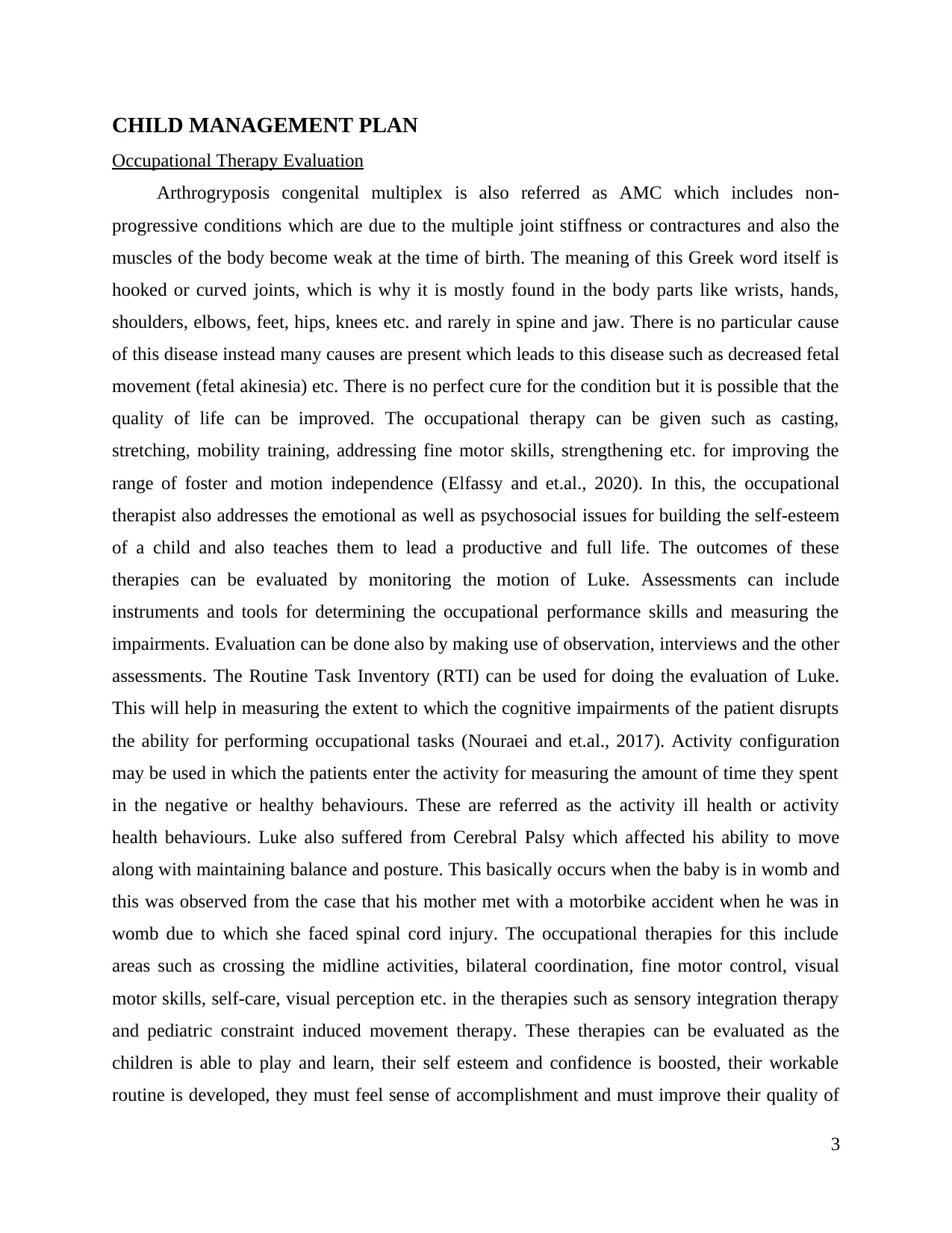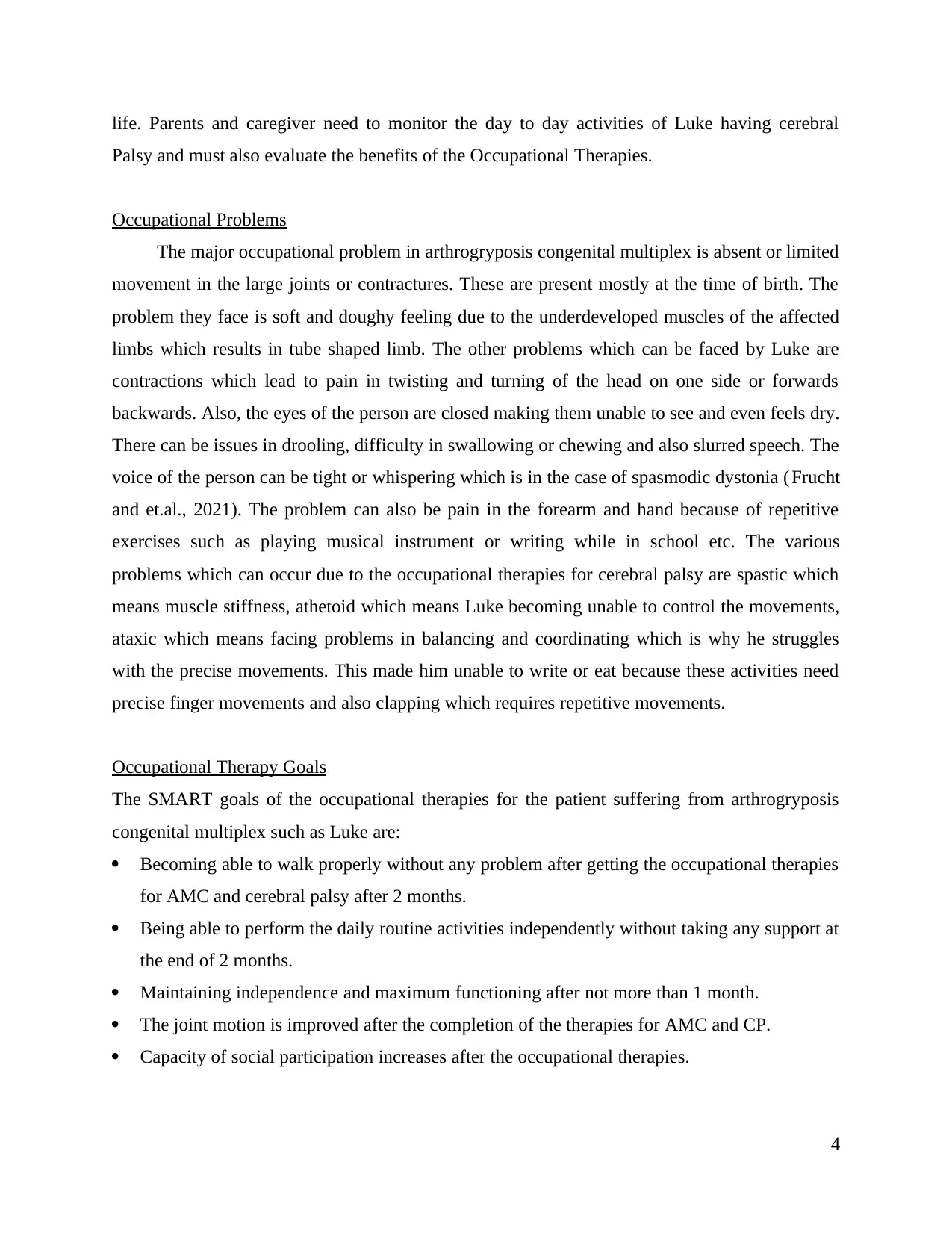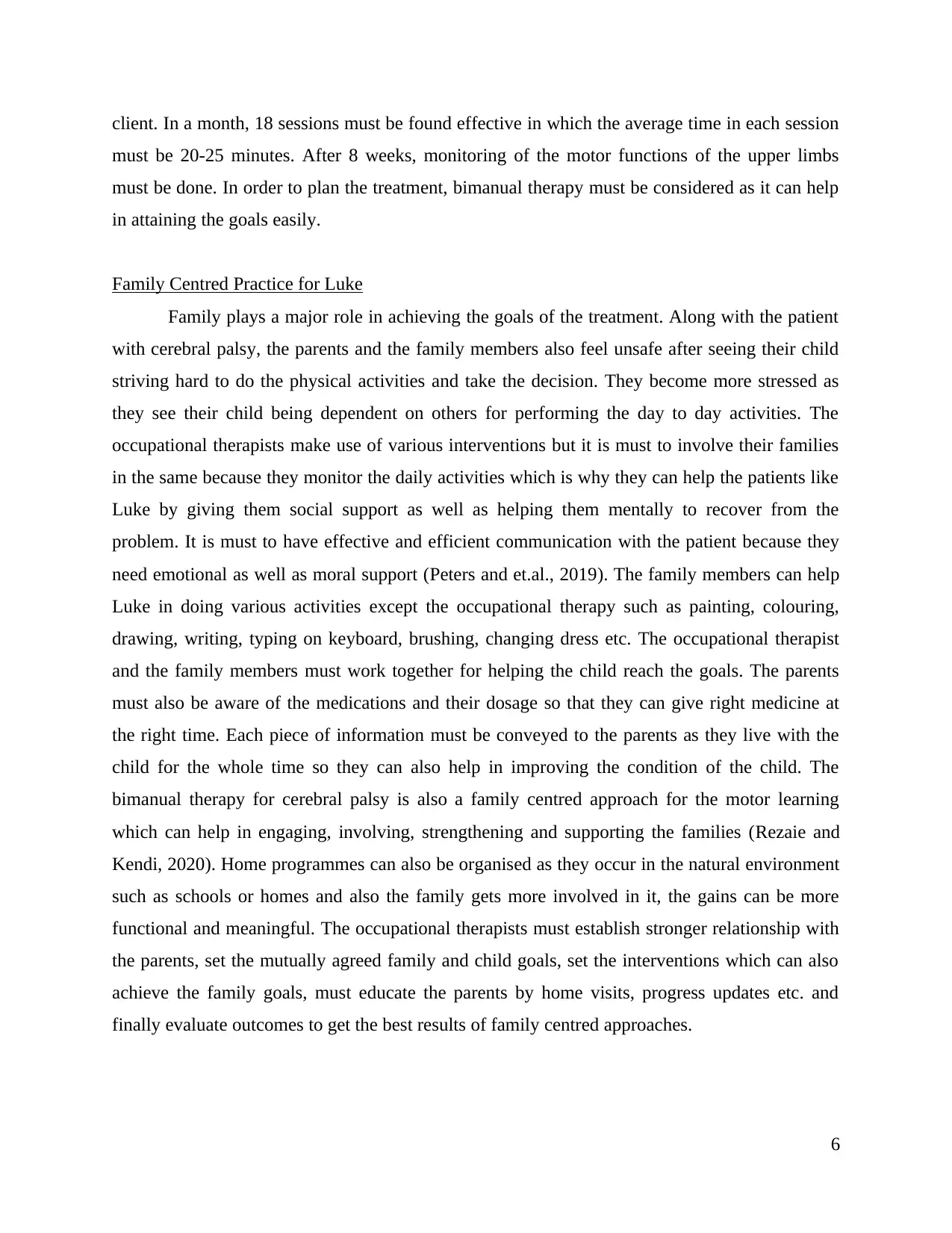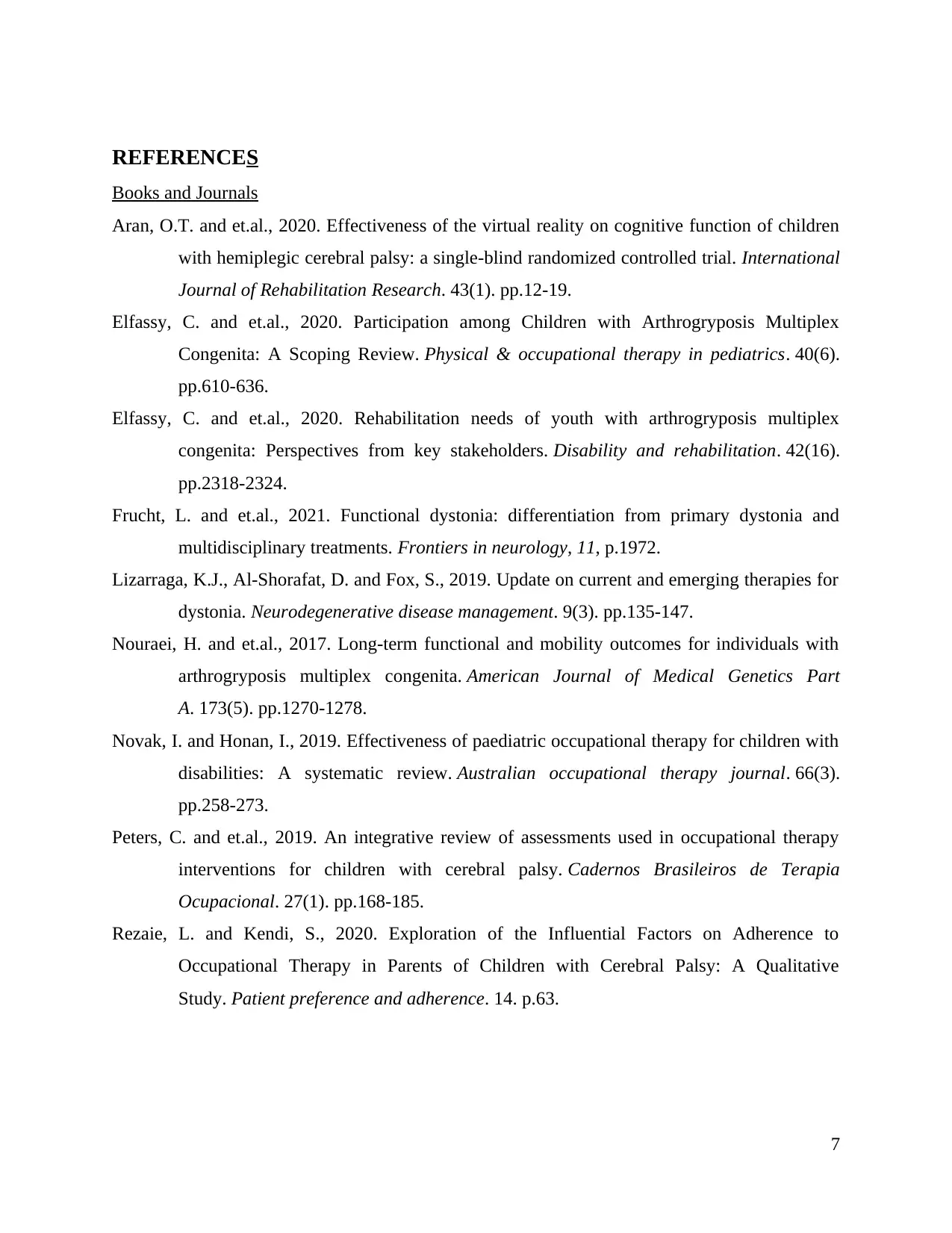Child Management Plan: Occupational Therapy for Luke's Conditions
VerifiedAdded on 2022/12/15
|7
|2145
|244
Report
AI Summary
This report presents a comprehensive child management plan centered around occupational therapy for a child named Luke, diagnosed with Arthrogryposis Congenital Multiplex (AMC) and Cerebral Palsy (CP). The plan begins with an occupational therapy evaluation, discussing the conditions, their impact on the child's occupational performance, and the problems faced, including limited movement, muscle weakness, and difficulties with fine motor skills and balance. It outlines specific, measurable, achievable, relevant, and time-bound (SMART) goals for therapy, aiming to improve mobility, independence in daily activities, social participation, and communication skills. The intervention section details various therapeutic approaches, such as bimanual training, adaptive equipment, and muscle-strengthening exercises, emphasizing the importance of family-centered practice and the involvement of parents and caregivers. The report also highlights the significance of regular monitoring, home programs, and effective communication to ensure the child's progress and well-being, while providing references to relevant literature.

CLIENT MANAGEMENT
PLAN
PLAN
Paraphrase This Document
Need a fresh take? Get an instant paraphrase of this document with our AI Paraphraser

TABLE OF CONTENTS
CHILD MANAGEMENT PLAN....................................................................................................3
Occupational Therapy Evaluation...............................................................................................3
Occupational Problems................................................................................................................4
Occupational Therapy Goals.......................................................................................................4
Occupational Therapy Intervention.............................................................................................5
Family Centred Practice for Luke................................................................................................6
REFERENCES................................................................................................................................7
CHILD MANAGEMENT PLAN....................................................................................................3
Occupational Therapy Evaluation...............................................................................................3
Occupational Problems................................................................................................................4
Occupational Therapy Goals.......................................................................................................4
Occupational Therapy Intervention.............................................................................................5
Family Centred Practice for Luke................................................................................................6
REFERENCES................................................................................................................................7

CHILD MANAGEMENT PLAN
Occupational Therapy Evaluation
Arthrogryposis congenital multiplex is also referred as AMC which includes non-
progressive conditions which are due to the multiple joint stiffness or contractures and also the
muscles of the body become weak at the time of birth. The meaning of this Greek word itself is
hooked or curved joints, which is why it is mostly found in the body parts like wrists, hands,
shoulders, elbows, feet, hips, knees etc. and rarely in spine and jaw. There is no particular cause
of this disease instead many causes are present which leads to this disease such as decreased fetal
movement (fetal akinesia) etc. There is no perfect cure for the condition but it is possible that the
quality of life can be improved. The occupational therapy can be given such as casting,
stretching, mobility training, addressing fine motor skills, strengthening etc. for improving the
range of foster and motion independence (Elfassy and et.al., 2020). In this, the occupational
therapist also addresses the emotional as well as psychosocial issues for building the self-esteem
of a child and also teaches them to lead a productive and full life. The outcomes of these
therapies can be evaluated by monitoring the motion of Luke. Assessments can include
instruments and tools for determining the occupational performance skills and measuring the
impairments. Evaluation can be done also by making use of observation, interviews and the other
assessments. The Routine Task Inventory (RTI) can be used for doing the evaluation of Luke.
This will help in measuring the extent to which the cognitive impairments of the patient disrupts
the ability for performing occupational tasks (Nouraei and et.al., 2017). Activity configuration
may be used in which the patients enter the activity for measuring the amount of time they spent
in the negative or healthy behaviours. These are referred as the activity ill health or activity
health behaviours. Luke also suffered from Cerebral Palsy which affected his ability to move
along with maintaining balance and posture. This basically occurs when the baby is in womb and
this was observed from the case that his mother met with a motorbike accident when he was in
womb due to which she faced spinal cord injury. The occupational therapies for this include
areas such as crossing the midline activities, bilateral coordination, fine motor control, visual
motor skills, self-care, visual perception etc. in the therapies such as sensory integration therapy
and pediatric constraint induced movement therapy. These therapies can be evaluated as the
children is able to play and learn, their self esteem and confidence is boosted, their workable
routine is developed, they must feel sense of accomplishment and must improve their quality of
3
Occupational Therapy Evaluation
Arthrogryposis congenital multiplex is also referred as AMC which includes non-
progressive conditions which are due to the multiple joint stiffness or contractures and also the
muscles of the body become weak at the time of birth. The meaning of this Greek word itself is
hooked or curved joints, which is why it is mostly found in the body parts like wrists, hands,
shoulders, elbows, feet, hips, knees etc. and rarely in spine and jaw. There is no particular cause
of this disease instead many causes are present which leads to this disease such as decreased fetal
movement (fetal akinesia) etc. There is no perfect cure for the condition but it is possible that the
quality of life can be improved. The occupational therapy can be given such as casting,
stretching, mobility training, addressing fine motor skills, strengthening etc. for improving the
range of foster and motion independence (Elfassy and et.al., 2020). In this, the occupational
therapist also addresses the emotional as well as psychosocial issues for building the self-esteem
of a child and also teaches them to lead a productive and full life. The outcomes of these
therapies can be evaluated by monitoring the motion of Luke. Assessments can include
instruments and tools for determining the occupational performance skills and measuring the
impairments. Evaluation can be done also by making use of observation, interviews and the other
assessments. The Routine Task Inventory (RTI) can be used for doing the evaluation of Luke.
This will help in measuring the extent to which the cognitive impairments of the patient disrupts
the ability for performing occupational tasks (Nouraei and et.al., 2017). Activity configuration
may be used in which the patients enter the activity for measuring the amount of time they spent
in the negative or healthy behaviours. These are referred as the activity ill health or activity
health behaviours. Luke also suffered from Cerebral Palsy which affected his ability to move
along with maintaining balance and posture. This basically occurs when the baby is in womb and
this was observed from the case that his mother met with a motorbike accident when he was in
womb due to which she faced spinal cord injury. The occupational therapies for this include
areas such as crossing the midline activities, bilateral coordination, fine motor control, visual
motor skills, self-care, visual perception etc. in the therapies such as sensory integration therapy
and pediatric constraint induced movement therapy. These therapies can be evaluated as the
children is able to play and learn, their self esteem and confidence is boosted, their workable
routine is developed, they must feel sense of accomplishment and must improve their quality of
3
⊘ This is a preview!⊘
Do you want full access?
Subscribe today to unlock all pages.

Trusted by 1+ million students worldwide

life. Parents and caregiver need to monitor the day to day activities of Luke having cerebral
Palsy and must also evaluate the benefits of the Occupational Therapies.
Occupational Problems
The major occupational problem in arthrogryposis congenital multiplex is absent or limited
movement in the large joints or contractures. These are present mostly at the time of birth. The
problem they face is soft and doughy feeling due to the underdeveloped muscles of the affected
limbs which results in tube shaped limb. The other problems which can be faced by Luke are
contractions which lead to pain in twisting and turning of the head on one side or forwards
backwards. Also, the eyes of the person are closed making them unable to see and even feels dry.
There can be issues in drooling, difficulty in swallowing or chewing and also slurred speech. The
voice of the person can be tight or whispering which is in the case of spasmodic dystonia (Frucht
and et.al., 2021). The problem can also be pain in the forearm and hand because of repetitive
exercises such as playing musical instrument or writing while in school etc. The various
problems which can occur due to the occupational therapies for cerebral palsy are spastic which
means muscle stiffness, athetoid which means Luke becoming unable to control the movements,
ataxic which means facing problems in balancing and coordinating which is why he struggles
with the precise movements. This made him unable to write or eat because these activities need
precise finger movements and also clapping which requires repetitive movements.
Occupational Therapy Goals
The SMART goals of the occupational therapies for the patient suffering from arthrogryposis
congenital multiplex such as Luke are:
Becoming able to walk properly without any problem after getting the occupational therapies
for AMC and cerebral palsy after 2 months.
Being able to perform the daily routine activities independently without taking any support at
the end of 2 months.
Maintaining independence and maximum functioning after not more than 1 month.
The joint motion is improved after the completion of the therapies for AMC and CP.
Capacity of social participation increases after the occupational therapies.
4
Palsy and must also evaluate the benefits of the Occupational Therapies.
Occupational Problems
The major occupational problem in arthrogryposis congenital multiplex is absent or limited
movement in the large joints or contractures. These are present mostly at the time of birth. The
problem they face is soft and doughy feeling due to the underdeveloped muscles of the affected
limbs which results in tube shaped limb. The other problems which can be faced by Luke are
contractions which lead to pain in twisting and turning of the head on one side or forwards
backwards. Also, the eyes of the person are closed making them unable to see and even feels dry.
There can be issues in drooling, difficulty in swallowing or chewing and also slurred speech. The
voice of the person can be tight or whispering which is in the case of spasmodic dystonia (Frucht
and et.al., 2021). The problem can also be pain in the forearm and hand because of repetitive
exercises such as playing musical instrument or writing while in school etc. The various
problems which can occur due to the occupational therapies for cerebral palsy are spastic which
means muscle stiffness, athetoid which means Luke becoming unable to control the movements,
ataxic which means facing problems in balancing and coordinating which is why he struggles
with the precise movements. This made him unable to write or eat because these activities need
precise finger movements and also clapping which requires repetitive movements.
Occupational Therapy Goals
The SMART goals of the occupational therapies for the patient suffering from arthrogryposis
congenital multiplex such as Luke are:
Becoming able to walk properly without any problem after getting the occupational therapies
for AMC and cerebral palsy after 2 months.
Being able to perform the daily routine activities independently without taking any support at
the end of 2 months.
Maintaining independence and maximum functioning after not more than 1 month.
The joint motion is improved after the completion of the therapies for AMC and CP.
Capacity of social participation increases after the occupational therapies.
4
Paraphrase This Document
Need a fresh take? Get an instant paraphrase of this document with our AI Paraphraser

The ability of the person to communicate also increases which means Luke will be able to
communicate more effectively.
Luke will be able to live independently without any assistance.
The lower limbs of Luke will be aligned and the stability for ambulance must be established
(Lizarraga, Al-Shorafat and Fox, 2019).
The upper limbs must be able to function for the self-care at the end of completion of 3
months.
The abnormal postures must become correct after taking the treatment for dystonia.
The pain in the joints must be reduced along with the prevention of contractures.
The involuntary movements must be ameliorated after 1 month.
The overall function and the quality of life must be improved (Elfassy and et.al., 2020).
Occupational Therapy Intervention
There can be various interventions which can help in improving Luke who is suffering from
cerebral palsy. One major intervention is selection of the therapeutic activities and also focussing
on the family goals. These can be the parent education, positive behaviour support, strength
training, constraint induced movement therapy, recreation or the sports therapy, goal oriented
training, play therapy, adaptive equipments etc. Bimanual training which is also considered as
the Hand Arm Bimanual Intensive Therapy (HABIT) can be implemented. This will help the
child in improving the movement of the muscles. It will not make use of any physical restraints
but it will use the explicit instructions regarding the ways in which hand should be used before
performing any activity (Novak and Honan, 2019). The bimanual activities can be done and the
children must be actively involved in the same. This will also help in driving the motor cortex
plasticity as compared to the unstructured practice groups. In order to improve the movement
issues, various specialist interventions can be used such as the training and equipments for the
movement such as wheelchairs, walking frames, footwear, orthotics, supportive seating etc. as
they can encourage Luke to perform the day to day movement skills such as dressing, walking,
playing, sitting, toileting etc. The occupational therapists must lay emphasis to prevent the
impairments which impacts the movement by making use of orthotics, casts and muscle
strengthening exercises (Aran and et.al., 2020). The occupational therapists must also decide the
frequency of the therapies and interventions which is attainable and possible for them and the
5
communicate more effectively.
Luke will be able to live independently without any assistance.
The lower limbs of Luke will be aligned and the stability for ambulance must be established
(Lizarraga, Al-Shorafat and Fox, 2019).
The upper limbs must be able to function for the self-care at the end of completion of 3
months.
The abnormal postures must become correct after taking the treatment for dystonia.
The pain in the joints must be reduced along with the prevention of contractures.
The involuntary movements must be ameliorated after 1 month.
The overall function and the quality of life must be improved (Elfassy and et.al., 2020).
Occupational Therapy Intervention
There can be various interventions which can help in improving Luke who is suffering from
cerebral palsy. One major intervention is selection of the therapeutic activities and also focussing
on the family goals. These can be the parent education, positive behaviour support, strength
training, constraint induced movement therapy, recreation or the sports therapy, goal oriented
training, play therapy, adaptive equipments etc. Bimanual training which is also considered as
the Hand Arm Bimanual Intensive Therapy (HABIT) can be implemented. This will help the
child in improving the movement of the muscles. It will not make use of any physical restraints
but it will use the explicit instructions regarding the ways in which hand should be used before
performing any activity (Novak and Honan, 2019). The bimanual activities can be done and the
children must be actively involved in the same. This will also help in driving the motor cortex
plasticity as compared to the unstructured practice groups. In order to improve the movement
issues, various specialist interventions can be used such as the training and equipments for the
movement such as wheelchairs, walking frames, footwear, orthotics, supportive seating etc. as
they can encourage Luke to perform the day to day movement skills such as dressing, walking,
playing, sitting, toileting etc. The occupational therapists must lay emphasis to prevent the
impairments which impacts the movement by making use of orthotics, casts and muscle
strengthening exercises (Aran and et.al., 2020). The occupational therapists must also decide the
frequency of the therapies and interventions which is attainable and possible for them and the
5

client. In a month, 18 sessions must be found effective in which the average time in each session
must be 20-25 minutes. After 8 weeks, monitoring of the motor functions of the upper limbs
must be done. In order to plan the treatment, bimanual therapy must be considered as it can help
in attaining the goals easily.
Family Centred Practice for Luke
Family plays a major role in achieving the goals of the treatment. Along with the patient
with cerebral palsy, the parents and the family members also feel unsafe after seeing their child
striving hard to do the physical activities and take the decision. They become more stressed as
they see their child being dependent on others for performing the day to day activities. The
occupational therapists make use of various interventions but it is must to involve their families
in the same because they monitor the daily activities which is why they can help the patients like
Luke by giving them social support as well as helping them mentally to recover from the
problem. It is must to have effective and efficient communication with the patient because they
need emotional as well as moral support (Peters and et.al., 2019). The family members can help
Luke in doing various activities except the occupational therapy such as painting, colouring,
drawing, writing, typing on keyboard, brushing, changing dress etc. The occupational therapist
and the family members must work together for helping the child reach the goals. The parents
must also be aware of the medications and their dosage so that they can give right medicine at
the right time. Each piece of information must be conveyed to the parents as they live with the
child for the whole time so they can also help in improving the condition of the child. The
bimanual therapy for cerebral palsy is also a family centred approach for the motor learning
which can help in engaging, involving, strengthening and supporting the families (Rezaie and
Kendi, 2020). Home programmes can also be organised as they occur in the natural environment
such as schools or homes and also the family gets more involved in it, the gains can be more
functional and meaningful. The occupational therapists must establish stronger relationship with
the parents, set the mutually agreed family and child goals, set the interventions which can also
achieve the family goals, must educate the parents by home visits, progress updates etc. and
finally evaluate outcomes to get the best results of family centred approaches.
6
must be 20-25 minutes. After 8 weeks, monitoring of the motor functions of the upper limbs
must be done. In order to plan the treatment, bimanual therapy must be considered as it can help
in attaining the goals easily.
Family Centred Practice for Luke
Family plays a major role in achieving the goals of the treatment. Along with the patient
with cerebral palsy, the parents and the family members also feel unsafe after seeing their child
striving hard to do the physical activities and take the decision. They become more stressed as
they see their child being dependent on others for performing the day to day activities. The
occupational therapists make use of various interventions but it is must to involve their families
in the same because they monitor the daily activities which is why they can help the patients like
Luke by giving them social support as well as helping them mentally to recover from the
problem. It is must to have effective and efficient communication with the patient because they
need emotional as well as moral support (Peters and et.al., 2019). The family members can help
Luke in doing various activities except the occupational therapy such as painting, colouring,
drawing, writing, typing on keyboard, brushing, changing dress etc. The occupational therapist
and the family members must work together for helping the child reach the goals. The parents
must also be aware of the medications and their dosage so that they can give right medicine at
the right time. Each piece of information must be conveyed to the parents as they live with the
child for the whole time so they can also help in improving the condition of the child. The
bimanual therapy for cerebral palsy is also a family centred approach for the motor learning
which can help in engaging, involving, strengthening and supporting the families (Rezaie and
Kendi, 2020). Home programmes can also be organised as they occur in the natural environment
such as schools or homes and also the family gets more involved in it, the gains can be more
functional and meaningful. The occupational therapists must establish stronger relationship with
the parents, set the mutually agreed family and child goals, set the interventions which can also
achieve the family goals, must educate the parents by home visits, progress updates etc. and
finally evaluate outcomes to get the best results of family centred approaches.
6
⊘ This is a preview!⊘
Do you want full access?
Subscribe today to unlock all pages.

Trusted by 1+ million students worldwide

REFERENCES
Books and Journals
Aran, O.T. and et.al., 2020. Effectiveness of the virtual reality on cognitive function of children
with hemiplegic cerebral palsy: a single-blind randomized controlled trial. International
Journal of Rehabilitation Research. 43(1). pp.12-19.
Elfassy, C. and et.al., 2020. Participation among Children with Arthrogryposis Multiplex
Congenita: A Scoping Review. Physical & occupational therapy in pediatrics. 40(6).
pp.610-636.
Elfassy, C. and et.al., 2020. Rehabilitation needs of youth with arthrogryposis multiplex
congenita: Perspectives from key stakeholders. Disability and rehabilitation. 42(16).
pp.2318-2324.
Frucht, L. and et.al., 2021. Functional dystonia: differentiation from primary dystonia and
multidisciplinary treatments. Frontiers in neurology, 11, p.1972.
Lizarraga, K.J., Al-Shorafat, D. and Fox, S., 2019. Update on current and emerging therapies for
dystonia. Neurodegenerative disease management. 9(3). pp.135-147.
Nouraei, H. and et.al., 2017. Long‐term functional and mobility outcomes for individuals with
arthrogryposis multiplex congenita. American Journal of Medical Genetics Part
A. 173(5). pp.1270-1278.
Novak, I. and Honan, I., 2019. Effectiveness of paediatric occupational therapy for children with
disabilities: A systematic review. Australian occupational therapy journal. 66(3).
pp.258-273.
Peters, C. and et.al., 2019. An integrative review of assessments used in occupational therapy
interventions for children with cerebral palsy. Cadernos Brasileiros de Terapia
Ocupacional. 27(1). pp.168-185.
Rezaie, L. and Kendi, S., 2020. Exploration of the Influential Factors on Adherence to
Occupational Therapy in Parents of Children with Cerebral Palsy: A Qualitative
Study. Patient preference and adherence. 14. p.63.
7
Books and Journals
Aran, O.T. and et.al., 2020. Effectiveness of the virtual reality on cognitive function of children
with hemiplegic cerebral palsy: a single-blind randomized controlled trial. International
Journal of Rehabilitation Research. 43(1). pp.12-19.
Elfassy, C. and et.al., 2020. Participation among Children with Arthrogryposis Multiplex
Congenita: A Scoping Review. Physical & occupational therapy in pediatrics. 40(6).
pp.610-636.
Elfassy, C. and et.al., 2020. Rehabilitation needs of youth with arthrogryposis multiplex
congenita: Perspectives from key stakeholders. Disability and rehabilitation. 42(16).
pp.2318-2324.
Frucht, L. and et.al., 2021. Functional dystonia: differentiation from primary dystonia and
multidisciplinary treatments. Frontiers in neurology, 11, p.1972.
Lizarraga, K.J., Al-Shorafat, D. and Fox, S., 2019. Update on current and emerging therapies for
dystonia. Neurodegenerative disease management. 9(3). pp.135-147.
Nouraei, H. and et.al., 2017. Long‐term functional and mobility outcomes for individuals with
arthrogryposis multiplex congenita. American Journal of Medical Genetics Part
A. 173(5). pp.1270-1278.
Novak, I. and Honan, I., 2019. Effectiveness of paediatric occupational therapy for children with
disabilities: A systematic review. Australian occupational therapy journal. 66(3).
pp.258-273.
Peters, C. and et.al., 2019. An integrative review of assessments used in occupational therapy
interventions for children with cerebral palsy. Cadernos Brasileiros de Terapia
Ocupacional. 27(1). pp.168-185.
Rezaie, L. and Kendi, S., 2020. Exploration of the Influential Factors on Adherence to
Occupational Therapy in Parents of Children with Cerebral Palsy: A Qualitative
Study. Patient preference and adherence. 14. p.63.
7
1 out of 7
Related Documents
Your All-in-One AI-Powered Toolkit for Academic Success.
+13062052269
info@desklib.com
Available 24*7 on WhatsApp / Email
![[object Object]](/_next/static/media/star-bottom.7253800d.svg)
Unlock your academic potential
Copyright © 2020–2025 A2Z Services. All Rights Reserved. Developed and managed by ZUCOL.



